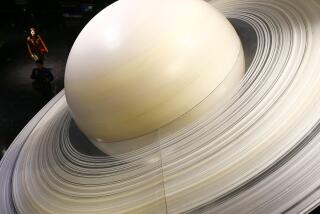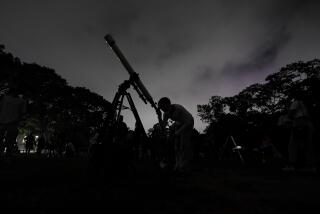6 More Planets Found Circling Other Suns
Astronomers have discovered six new planets orbiting nearby stars, bringing to 28 the total number of planets detected outside the solar system, an international research team said Monday.
The researchers--including scientists from UC Santa Cruz and UC Berkeley--turned up indirect but convincing evidence of the new extrasolar planets during a systematic investigation of 530 stars that are similar in size, age and brightness to the sun.
They also determined that four previously known planetary systems may be home to more than one planet. Until now, only one other system of multiple planets besides Earthâs system of nine planets had been found.
All of the new planets are too distant to be imaged directly. Even so, astronomers can detect the presence of a planet around a star by measuring a telltale wobble in the starâs motion caused by the gravitational force from the orbiting planet.
This month, however, astronomers did spot the silhouette of a planet circling another sun, confirming with a visual sighting that other worlds do exist beyond our own solar system.
The new findings increased by 25% the number of known extrasolar planets and suggest planets may be so common across the trackless star fields of space that there could easily be billions of planets in the galaxy of the Milky Way alone.
âIt says there are a lot of planets out there,â said UC Santa Cruz astrophysicist Steven Vogt. He detected the new planetary systems with colleagues at UC Berkeley, the Carnegie Institution of Washington and the University of Sussex. âPlanetary formation is a very common occurrence.â
Indeed, based on the current rate of discovery, Vogt said, âour galaxy alone could have over 10 billion planets in it.â
Discovered with the Keck Telescope in Hawaii, the six planets orbit stars that are at distances ranging from 65 to 192 light-years from Earth.
At least five of the planets orbit their stars in the so-called habitable zone, sufficiently close that they are warm enough to have liquid water, a basic requirement for life. The researchers estimated the temperature of one planet at 108 degrees Fahrenheit.
âThat is like a really hot day in Los Angeles,â Vogt said. Any moons orbiting the planets within the habitable zone, he said, âoffer the possibility of liquid water and the eventual emergence of life.â
The planets themselves range in mass from slightly smaller to almost seven times larger than the planet Jupiter. Like Jupiter, they are probably giant, crushing balls of hydrogen and helium gas.
Unlike Jupiter and the other gas giants of Earthâs solar system, the newly discovered planets revolve around their stars in quite eccentric, oval orbits, rather than in circular paths. One of the newly discovered planets dips to within 36 million miles of its star and then swings out to more than 214 million miles.
Of the planetary systems known so far, only the gas giants of Earthâs home system follow circular orbits, Vogt said.
âOur solar system is kind of rare,â Vogt said.
Details of their research, funded by the National Science Foundation, will be published in the Astrophysical Journal.






